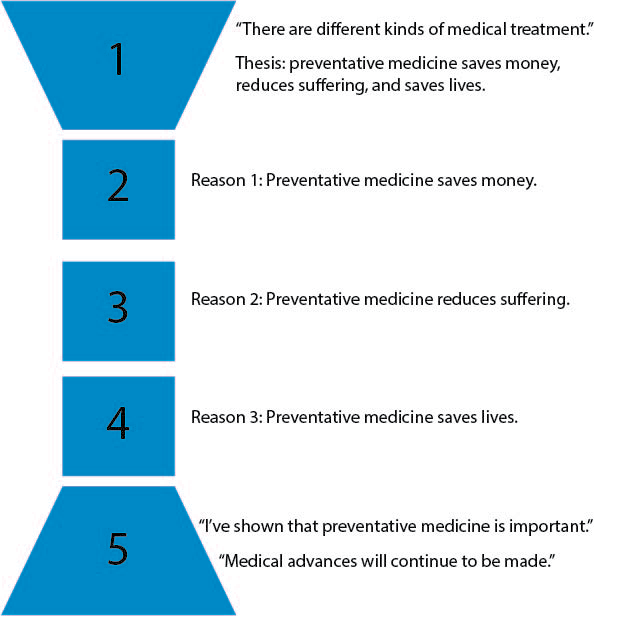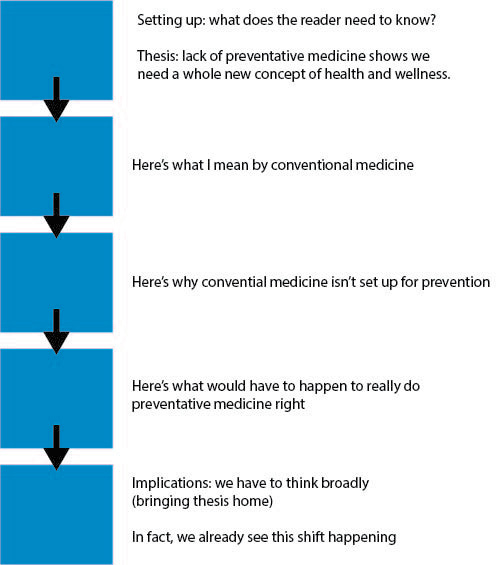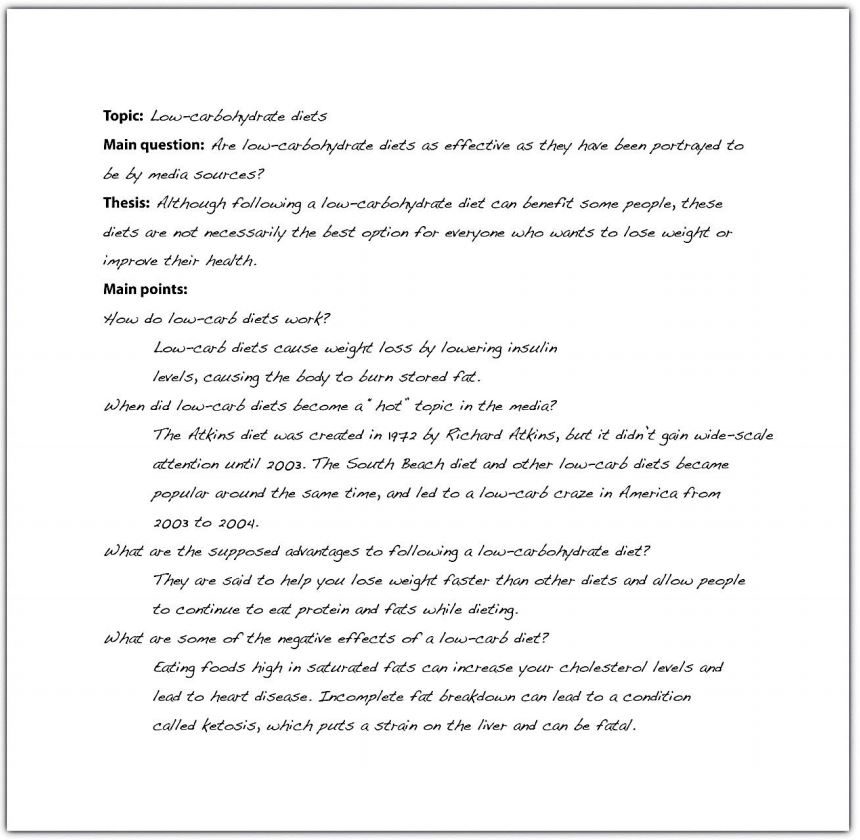Chapter 10: Essay Outlining
Moving beyond the five-paragraph structure
Some students assume that college writing is simply more of the same writing that they did in high school. The skills that go into a very basic kind of essay—often called the five-paragraph essay—are indispensable. If you’re good at the five-paragraph model, then you’re good at identifying a clear and consistent thesis, arranging cohesive paragraphs, organizing evidence for key points, and situating an argument within a broader context through the intro and conclusion. However, in college you need to build on those essential skills. The five-paragraph essay, as such, is bland and formulaic; it doesn’t compel deep thinking. Your professors are looking for a more ambitious and arguable thesis, a nuanced and compelling argument, and real-life evidence for all key points, all in an organically[1] structured paper.
If you’ve written a five-paragraph essay, the model below is probably what you’re used to: the introductory paragraph starts broad and gradually narrows to a thesis, which readers expect to find at the very end of that paragraph. In this idealized format, the thesis invokes the magic number of three: three reasons why a statement is true. Each of those reasons is explained and justified in the three body paragraphs, and then the final paragraph restates the thesis before gradually getting broader. This format is easy for readers to follow, and it helps writers organize their points and the evidence that goes with them. That’s why you learned this format.

However, college papers are more complex. The first key difference is the thesis. Rather than simply positing a number of reasons to think that something is true, it puts forward an arguable statement: one with which a reasonable person might disagree. An arguable thesis gives the paper purpose. It surprises readers and draws them in. You hope your reader thinks, “Huh. Why would they come to that conclusion?” and then feels compelled to read on. The body paragraphs, then, build on one another to carry out this ambitious argument. In the classic five-paragraph theme it hardly matters which of the three reasons you explain first or second. In the more organic structure each paragraph specifically leads to the next.
The last key difference is seen in the conclusion. Because the organic essay is driven by an ambitious, non-obvious argument, the reader comes to the concluding section thinking “OK, I’m convinced by the argument. What do you, author, make of it? Why does it matter?” The conclusion of an organically structured paper has a real job to do. It doesn’t just reiterate the thesis; it explains why the thesis matters.

The substantial time you spent mastering the five-paragraph form was time well spent; it’s hard to imagine anyone succeeding with the more organic form without the organizational skills and habits of mind inherent in the simpler form. But if you assume that you must adhere rigidly to the simpler form, you’re blunting your intellectual ambition. Your professors will not be impressed by obvious theses, loosely related body paragraphs, and repetitive conclusions. They want you to undertake an ambitious independent analysis, one that will yield a thesis that is somewhat surprising and challenging to explain.
synthesizing information
By now, your thinking on your topic is taking shape. You have a sense of what major ideas to address in your paper, what points you can easily support, and what questions or subtopics might need a little more thought. In short, you have begun the process of synthesizing information—that is, of putting the pieces together into a coherent whole. First, you have to figure out how you will organize the essay.
For some assignments, the organization of the paper may be determined by the instructor’s requirements. For instance, if you are asked to explore the impact of a new communications device, a cause-and-effect structure is obviously appropriate. In other cases, you will need to determine the structure based on what suits your topic and purpose.
Video source: https://youtu.be/yc53YcDMG_4
You need to keep these methods of organization in mind as you plan how to arrange the information you have gathered in an outline. An outline is a written plan that serves as a skeleton for the paragraphs you write. Later, when you draft paragraphs in the next stage of the writing process, you will add support to create “flesh” and “muscle” for your assignment.
When you write, your goal is not only to complete an assignment but also to write for a specific purpose—perhaps to inform, to explain, to persuade, or a combination of these purposes. Your purpose for writing should always be in the back of your mind, because it will help you decide which pieces of information belong together and how you will order them. In other words, choose the order that will most effectively fit your purpose and support your main point.
Order versus Purpose
| Order | Purpose |
| Chronological Order | To explain the history of an event or a topic |
| To tell a story or relate an experience | |
| To explain how to do or make something | |
| To explain the steps in a process | |
| Spatial Order | To help readers visualize something as you want them to see it |
| To create a main impression using the senses (sight, touch, taste, smell, and sound) | |
| Order of Importance | To persuade or convince |
| To rank items by their importance, benefit, or significance | |
Writing an Outline
Now it’s time to organize your notes and data as an essay outline. As you proceed, you might identify some more important subtopics that were not part of your original plan, or you might decide that some points are not relevant to your paper.
Remember, your ideas and conclusions will shape the paper. They are the glue that holds the rest of the content together. As you work, begin jotting down the big ideas you will use to connect the dots for your reader. (If you are not sure where to begin, try answering your major research question and sub-questions. Add and answer new questions as appropriate.) You might record these big ideas on sticky notes or type and highlight them within an electronic document.
You may be wondering how your ideas are supposed to shape the paper, especially since you are writing a research paper based on your research. Integrating your ideas and your information from research is a complex process, and sometimes it can be difficult to separate the two.
Some paragraphs in your paper will consist mostly of details from your research. That is fine, as long as you explain what those details mean or how they are linked. You should also include sentences and transitions that show the relationship between different facts from your research by grouping related ideas or pointing out connections or contrasts. The result is that you are not simply presenting information; you are synthesizing, analyzing, and interpreting it.
Video source: https://youtu.be/hwzfnDbZCRQ
Selecting Useful Information
At this point in the research process, you have gathered information from a wide variety of sources. Now it is time to think about how you will use this information.
When you conduct research, you keep an open mind and seek out many promising sources. You take notes on any information that looks like it might help you answer your research questions. Often, new ideas and terms come up in your reading, and these, too, find their way into your notes. You may record facts or quotations that catch your attention even if they did not seem immediately relevant to your research question. By now, you have probably amassed an impressively detailed collection of notes. You will not use all of your notes in your paper.
Good researchers are thorough. They look at multiple perspectives, facts, and ideas related to their topic, and they gather a great deal of information. Effective writers, however, are selective. They determine which information is most relevant and appropriate for their purpose. They include details that develop or explain their ideas—and they leave out details that do not. The writer, not the pile of notes, is the controlling force. The writer shapes the content of the research paper.
Now you will apply your critical thinking skills to the information you recorded—analyzing how it is relevant, determining how it meshes with your ideas, and finding how it forms connections and patterns.
Identify Information That Supports Your Thesis
Begin by identifying the notes that clearly support your thesis. Mark or group these, either physically or using the cut-and-paste function in your word processing program. As you identify the crucial details that support your thesis, make sure you analyze them critically. Ask the following questions to focus your thinking:
- Is this detail from a reliable, high-quality source? Is it appropriate for me to cite this source in an academic paper? The bulk of the support for your thesis should come from reliable, reputable sources. If most of the details that support your thesis are from less-reliable sources, you may need to do additional research or modify your thesis.
- Is the link between this information and my thesis obvious, or will I need to explain it to my readers? Remember, you have spent more time thinking and reading about this topic than your audience. Some connections might be obvious to both you and your readers. More often, however, you will need to provide the analysis or explanation that shows how the information supports your thesis. As you read through your notes, jot down ideas you have for making those connections clear.
- What personal biases or experiences might affect the way I interpret this information? No researcher is 100 percent objective. We all have personal opinions and experiences that influence our reactions to what we read and learn. Good researchers are aware of this human tendency. They keep an open mind when they read opinions or facts that contradict their beliefs.
Find Connections between Your Sources
As you find connections between your ideas and information in your sources, also look for information that connects your sources. Do most sources seem to agree on a particular idea? Are some facts mentioned repeatedly in many different sources? What key terms or major concepts come up in most of your sources regardless of whether the sources agree on the finer points? Identifying these connections will help you identify important ideas to discuss in your paper.
Look for subtler ways your sources complement one another, too. Does one author refer to another’s book or article? How do sources that are more recent build upon the ideas developed in earlier sources?
Be aware of any redundancies in your sources. If you have amassed solid support from a reputable source, such as a scholarly journal, there is no need to cite the same facts from an online encyclopedia article that is many steps removed from any primary research. If a given source adds nothing new to your discussion and you can cite a stronger source for the same information, use the stronger source.
Determine how you will address any contradictions found among different sources. For instance, if one source cites a startling fact that you cannot confirm anywhere else, it is safe to dismiss the information as unreliable. However, if you find significant disagreements among reliable sources, you will need to review them and evaluate each source. Which source presents a more sound argument or more solid evidence? It is up to you to determine which source is the most credible and why.
Finally, do not ignore any information simply because it does not support your thesis. Carefully consider how that information fits into the big picture of your research. You may decide that the source is unreliable or the information is not relevant, or you may decide that it is an important point you need to bring up. What matters is that you give it careful consideration.
PowerPoint presentations, used both in schools and in the workplace, are organized in a way very similar to formal outlines. PowerPoint presentations often contain information in the form of talking points that the presenter develops with more details and examples than are contained on the PowerPoint slide.
- “Organic” here doesn’t mean “pesticide-free” or containing carbon; it means the paper grows and develops, sort of like a living thing. ↵


